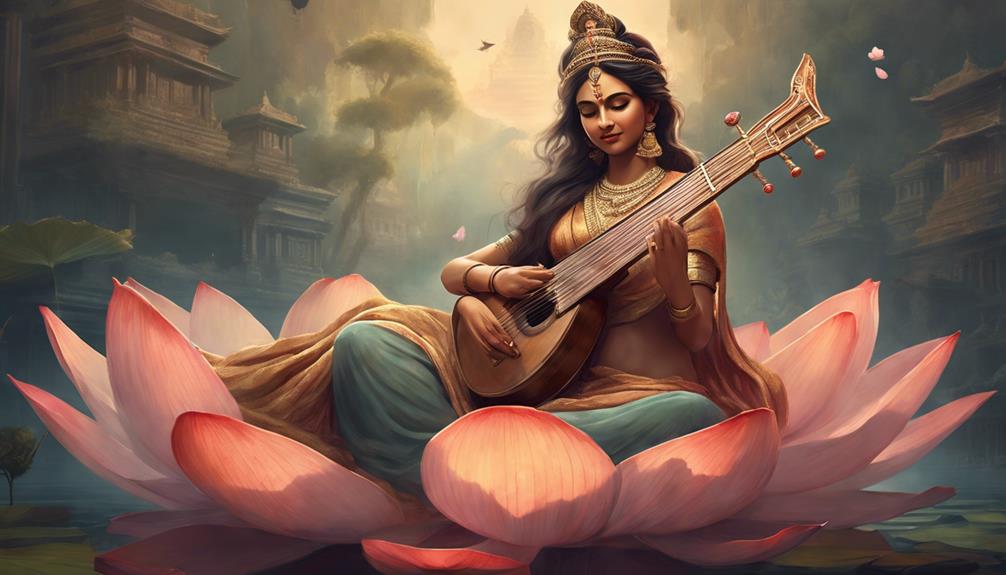Discover the divine Goddess Saraswati, revered for embodying knowledge, arts, and wisdom in Hindu mythology. Symbolizing creativity and intellect, she inspires learning and artistic endeavors. Portrayed with four arms, holding symbols like the Veena and Lotus, she signifies purity, enlightenment, and spiritual rebirth. The Swan symbolizes wisdom, while books represent a repository of knowledge and spiritual growth. By exploring her symbolism, you'll uncover a profound world of spiritual enlightenment and artistic inspiration waiting to be revealed.
Table of Contents
Key Takeaways
- Saraswati embodies knowledge, music, arts, and wisdom in Hindu mythology.
- Depicted with four arms holding sacred scripture, vina, mala, and lotus.
- Veena symbolizes creativity, while lotus signifies purity and spiritual rebirth.
- The swan symbol associated with profound wisdom and discernment.
- Books in Saraswati's iconography represent the pursuit of knowledge and spiritual growth.
Origins of Goddess Saraswati
The origins of Goddess Saraswati can be traced back to ancient Hindu mythology, where she's revered as the embodiment of knowledge, music, arts, and wisdom. Saraswati's influence and cultural significance are profound, as she symbolizes the core of creativity and intellect in Hindu traditions. Her role as the divine inspiration for learning and the arts has made her a revered figure among scholars, musicians, and artists throughout history.
In Hindu mythology, Saraswati is depicted as a graceful deity adorned in white, symbolizing purity and knowledge. She's often portrayed playing the veena, a musical instrument representing the harmony of creation. Saraswati's association with literature, poetry, and learning underscores her importance as the patroness of education and creativity.
The cultural significance of Goddess Saraswati extends beyond religious contexts, permeating various aspects of Indian society. Her presence is felt in educational institutions, where students seek her blessings for success in their academic pursuits. Artists invoke her name before starting new creative ventures, seeking inspiration and guidance in their artistic endeavors. Essentially, Goddess Saraswati's divine essence continues to inspire and guide individuals in their quest for knowledge and creativity.
Depiction and Iconography
Symbolizing purity and knowledge, Goddess Saraswati's depiction and iconography in Hindu mythology exude grace and reverence. She's often portrayed with four arms, symbolizing her omnipresence and omnipotence. In one hand, she holds a sacred scripture, representing divine knowledge, while another hand holds a vina, symbolizing the arts and creativity. The other two hands hold a mala (rosary) and a lotus, signifying spirituality and purity.
Artistic interpretations of Goddess Saraswati often depict her sitting on a white lotus, symbolizing light, knowledge, and truth. Her serene countenance and calm demeanor reflect her role as the embodiment of wisdom and learning. The flowing white attire she wears signifies purity and peace. The swan beside her isn't just a decorative element but signifies discernment and the ability to separate the good from the bad. Artists often infuse her depiction with intricate details and vibrant colors to capture the essence of her divine presence. Through meticulous depiction analysis, one can marvel at the intricate symbolism and artistic representation of Goddess Saraswati in Hindu mythology.
Symbolism of the Veena

Embodying the essence of creativity and artistic expression, the veena in Goddess Saraswati's iconography symbolizes a profound connection to the arts and the divine. The veena holds significant symbolic value as it represents musical inspiration and instrument significance in Hindu mythology. Saraswati, playing the veena, epitomizes the flow of creativity and knowledge that emanates through music. The veena's melodious tunes are believed to resonate with the rhythm of the universe, creating harmony and balance.
In Hindu culture, the veena is revered as a sacred instrument that has the power to evoke deep emotions and spiritual awakening. Its strings are likened to the interconnectedness of all aspects of life, symbolizing the union of body, mind, and soul. When Saraswati is depicted playing the veena, it signifies the harmonious blend of intellect and artistry, encouraging devotees to seek enlightenment through creative expression.
Lotus Symbolism
In Hindu symbolism, the lotus holds profound spiritual significance as a sacred flower representing purity and enlightenment. The lotus symbolizes purity and beauty, as it emerges from muddy waters unstained, resembling the journey towards spiritual perfection amidst the chaos of the material world. Its exquisite petals unfolding gracefully mirror the unfolding of spiritual consciousness in an individual's life.
Moreover, the lotus is a symbol of enlightenment and rebirth. Just as the lotus rises from the murky depths to bloom in the sunlight, it signifies the journey from darkness to light, from ignorance to knowledge. The unfolding of its petals symbolizes the expansion of the soul and the attainment of spiritual awakening. In Hindu mythology, deities are often depicted sitting on or holding lotus flowers, underscoring the divine beauty and purity associated with this revered flower.
Therefore, the lotus in Hindu symbolism serves as a powerful reminder of the human quest for purity, enlightenment, and spiritual rebirth.
Importance of Swan Symbol

The swan holds significant importance in Goddess Saraswati's symbolism for several key reasons. It's commonly associated with wisdom, symbolizing the pursuit of knowledge and enlightenment.
In art, the swan's graceful presence embodies elegance and purity, reflecting the divine qualities that Saraswati represents.
Swan as Wisdom Symbol
Symbolizing profound wisdom and discernment, the swan holds a significant place in the mythology and symbolism associated with Goddess Saraswati. Known for their grace and elegance, swans exhibit remarkable intelligence in their behavior, often displaying problem-solving skills and social interactions that hint at a deeper understanding of their environment.
While some swan species are migratory, traversing great distances to find suitable habitats, others prefer serene lakes and ponds, symbolizing tranquility and contemplation. In Hindu mythology, the swan is revered for its ability to separate milk from water, representing the importance of distinguishing truth from illusion. This symbolism aligns perfectly with Goddess Saraswati's attributes of knowledge, creativity, and insight, emphasizing the swan's role as a timeless symbol of wisdom.
Swan in Art
With its graceful presence and rich symbolism, the swan in art captivates viewers with its representation of wisdom and beauty. Swan elegance is often portrayed in various art forms, symbolizing purity, grace, and elegance.
Artists throughout history have been drawn to the swan as a subject due to its aesthetic appeal and the deeper meanings it conveys. The swan's white plumage and serene demeanor make it a perfect symbol for purity and spiritual beauty in artistic expression.
In paintings, sculptures, and other art mediums, the swan is depicted in different contexts, each highlighting its elegance and grace. The swan's presence in art serves as a reminder of the harmonious balance between beauty and wisdom in artistic creation.
Swans Graceful Movement
Enthralling observers with its fluid and graceful movements, the swan symbolizes elegance and beauty in art, embodying a profound significance that transcends mere aesthetic appeal.
As a graceful bird and a majestic water fowl, the swan's symbolic presence is deeply rooted in various cultures and mythologies. In Hinduism, the swan is often associated with the Goddess Saraswati, representing purity, creativity, and wisdom. Its serene glide across the water mirrors the goddess's serene demeanor and profound knowledge.
The swan's effortless movement reflects a sense of tranquility and grace, inspiring artists and poets alike. Through its symbolic significance, the swan serves as a reminder of the beauty and elegance that can be found in both art and nature.
Books and Knowledge

As you explore the symbolism of books and knowledge in connection with Goddess Saraswati, you'll discover a profound representation of wisdom and learning.
Books in the hands of Goddess Saraswati signify the importance of education, enlightenment, and the power of written words to convey knowledge.
This symbolism serves as a reminder of the divine inspiration that flows through the pursuit of knowledge and the significance of continuous learning in one's spiritual journey.
Symbolism of Books
Books hold a sacred significance in the symbolism of Goddess Saraswati, representing the profound connection between books and knowledge.
In Hindu mythology, books symbolize the repository of knowledge, wisdom, and learning that the Goddess bestows upon her devotees. The act of reading is seen as a powerful tool for acquiring knowledge and expanding one's intellect.
Saraswati is often depicted holding a book, emphasizing the importance of education and the pursuit of knowledge. The symbolism of books in relation to Goddess Saraswati underscores the belief that learning is a lifelong journey that leads to enlightenment and spiritual growth.
Knowledge Representation
The symbolic representation of knowledge through books in relation to Goddess Saraswati highlights the profound connection between learning and enlightenment in Hindu mythology. Books aren't merely physical objects but hold a deeper significance as repositories of knowledge and wisdom.
In Hindu tradition, books symbolize the vast expanse of learning and the importance of education in attaining spiritual enlightenment. Saraswati, as the goddess of knowledge, is often depicted holding a sacred scripture or playing a musical instrument symbolizing the power of sound and language in conveying wisdom.
The mythological significance of books in Saraswati's imagery emphasizes the belief that true knowledge is a path to self-realization and transcendence, guiding individuals towards intellectual growth and spiritual fulfillment.
Spiritual Significance
Symbolizing wisdom and creativity, Goddess Saraswati embodies the essence of spiritual enlightenment and artistic inspiration. In Hinduism, Saraswati is revered for her role in guiding individuals towards spiritual growth and inner transformation. As the goddess of knowledge and learning, she symbolizes the journey of expanding one's consciousness and attaining spiritual enlightenment through the pursuit of wisdom.
Worshipping Saraswati is believed to invoke her blessings, helping devotees in their quest for self-realization and deeper understanding of the universe. Through her association with music, arts, and literature, Saraswati inspires creativity and encourages individuals to express themselves authentically, thereby facilitating inner transformation.
Devotees often seek Saraswati's guidance to overcome ignorance and achieve mental clarity, paving the way for spiritual enlightenment. By acknowledging and honoring the goddess's significance, individuals invite her divine energy into their lives, fostering a deeper connection to their inner selves and the world around them. Ultimately, Saraswati serves as a beacon of light, illuminating the path towards self-discovery and spiritual growth.
Saraswati Puja Rituals

Guided by the wisdom and creativity symbolized by Goddess Saraswati, Saraswati Puja rituals serve as a sacred practice to honor and invoke her blessings for spiritual growth and enlightenment. Saraswati Puja traditions are rich in symbolism and significance, often observed during the spring season when nature is in full bloom, symbolizing the blossoming of knowledge and wisdom.
During Saraswati Puja, devotees prepare elaborate ceremonial offerings known as 'bhog' to present to the goddess. These offerings typically include fruits, flowers, sweets, and traditional dishes like khichuri and payesh. The act of offering these items is a gesture of gratitude and reverence towards Saraswati, seeking her divine blessings for success in academics, music, arts, and overall wisdom.
Devotees also engage in rituals like chanting hymns and mantras dedicated to Goddess Saraswati, meditating on her divine qualities, and seeking her guidance to dispel ignorance and usher in enlightenment. Through these sacred practices, Saraswati Puja becomes a transformative experience, fostering spiritual growth and a deeper connection with the goddess of knowledge and arts.
Frequently Asked Questions
Is Saraswati Considered to Be a Warrior Goddess Like Durga or Kali?
Saraswati, a scholarly icon and artistic inspiration, is not traditionally viewed as a warrior goddess like Durga or Kali. Instead, she embodies creative wisdom and intellect, symbolizing the pursuit of knowledge and artistic expression.
How Is Saraswati's Appearance Different in Different Regions of India?
In different regions of India, Saraswati's appearance varies, reflecting regional beliefs and traditions. These regional variations highlight the rich cultural significance and symbolism attached to the goddess, showcasing diverse depiction variations with profound meanings.
Are There Any Specific Rituals or Prayers Associated With Saraswati During Festivals Other Than Saraswati Puja?
During festivals, Saraswati is revered through ritualistic practices and prayers, embodying Vedic traditions. Her cultural significance extends beyond Saraswati Puja, symbolizing knowledge and learning. Worship of the goddess reflects deep-rooted educational symbolism in Indian traditions.
What Is the Significance of the Color White in Relation to Saraswati?
White symbolizes purity, wisdom, creativity, and divine inspiration in relation to Goddess Saraswati. It represents enlightenment and clarity of thought. Embracing this color invokes her essence, guiding you towards knowledge and artistic expression.
Are There Any Specific Mantras or Chants Dedicated to Saraswati That Are Commonly Recited?
When seeking mantras for Saraswati, consider "Om Aim Saraswatyai Namaha" for mantra meditation. This chant is commonly recited for spiritual growth and academic success. Engaging in this chanting practice can bring focus and wisdom.
Conclusion
To sum up, Goddess Saraswati is a revered deity in Hinduism symbolizing knowledge, creativity, and wisdom. Her depiction with a veena, lotus, and swan holds deep spiritual significance, representing the importance of music, purity, and discernment in one's pursuit of knowledge.
By honoring Saraswati through rituals and prayers, devotees seek her blessings to excel in academics, arts, and spiritual endeavors. Embracing her symbolism can inspire individuals to cultivate a life of learning and enlightenment.